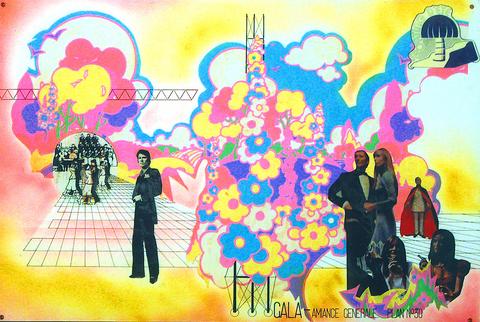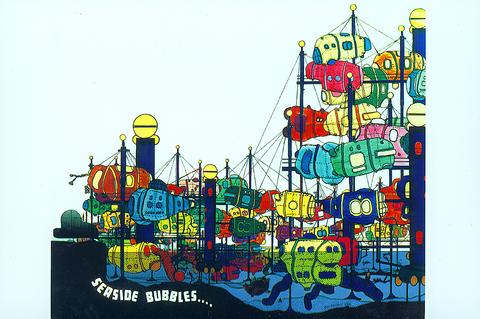Nowadays business deals have architects. Government policies have architects. There are even architects of sports victories. But architecture hasn't always permeated social consciousness, nor language.
An exhibition that opened yesterday at the Taipei Fine Arts Museum (TFAM), Archigram: Experimental Architecture 1961-1974, looks back to a major British movement that opened up architecture in these new ways and also helped define a 1960s futuristic aesthetic applied by others to Bond villains' headquarters, Monty Python's psychedelic animation and the Beatles' Yellow Submarine.
Archigram was founded as a magazine in 1961 by six London architects and then went on to spawn a movement. The magazine's pages were filled with manifestos, collaged space comics and fantastical drawings of an untold number of architectural projects, not one of which was ever built. It was a mod revolution that wanted to subvert stodgy urban landscapes with "gasket homes," "seaside bubbles," "underwater cities" and even an oil platform to be placed above Trafalgar Square.

PHOTO COURTESY OF TFAM
"We were designing non-houses, non-cities, non-building, non-places," said Peter Cook, one of Archigram's four surviving members and one of three in Taipei for the show's opening.
The designs were "anti-projects," and by the late 1960s they were part of the aesthetic and ideology of the "anti-establishment" movement. As architecture, the designs were, by and large, so imaginative that they were unbuildable. But they were imbued with a desire to dissolve cities, their existing hierarchies and their concrete exoskeletons. The term "archigram" was created by combining "architecture" with "telegram" and implied mobility, the lack of which they saw as an urban flaw to be rectified. So they invented "walking cities" that had legs and could move, "plug-in cities" that were interchangeable and "expendable place pads" as temporary, ad hoc homes. Drawings often called on materials that were inflatable, collapsible and not there when not needed. It was a vision of a society in flux.
In TFAM's galleries, these ideas are displayed in the form of more than 300 drawings, 14 architectural models and two extensive installations. Cook called it the second largest exhibition they've ever held in more than a decade of touring with their collection. One installation recreates a never-built 1969 design that fills a gallery with a Teletubby-like setting of astroturf, plastic flowers and inflatable dome homes. The second is a barrage of projected images, including a dozen slide projectors, video projectors and four television monitors.

PHOTO COURTESY OF TFAM
Much as American pop art is credited with bridging the gap between art and media, Archigram is credited with recognizing the confluence of architecture and advertising. (Imagine, for example, New York's Times Square or the Taipei Main Station MRT complex without ads ? it's virtually impossible because the ads are so central to what they are.)
Archigram member Michael Webb, also in Taipei for the opening, said that one of the things they realized was that "the labelling no longer applies," because in a dynamic environment, spaces can be used for anything. Advertisers discovered this long ago. As an example, Webb brought up the example of a New York commuter, a lawyer, who in a New York Times article claimed to actually enjoy the hours of traffic jams on his weekend commute because by employing a cell phone and a laptop computer sitting next to him in the passenger seat, it was the only time he could work without interruption.
"So you have this fellow doing all his work in an SUV, and still they build these office buildings everywhere. It doesn't work anymore, and it's still happening," said Webb.
"That's why we think the spirit of Archigram is still very much alive."
Archigram is on display through June 8 at the Taipei Fine Arts Museum (台北市立美術館) located at 181, Sec. 3, Chungshan N. Rd. (北市中山北路三段181號). Hours are 9:30am to 5:30pm Tuesday to Sunday.

The canonical shot of an East Asian city is a night skyline studded with towering apartment and office buildings, bright with neon and plastic signage, a landscape of energy and modernity. Another classic image is the same city seen from above, in which identical apartment towers march across the city, spilling out over nearby geography, like stylized soldiers colonizing new territory in a board game. Densely populated dynamic conurbations of money, technological innovation and convenience, it is hard to see the cities of East Asia as what they truly are: necropolises. Why is this? The East Asian development model, with

June 16 to June 22 The following flyer appeared on the streets of Hsinchu on June 12, 1895: “Taipei has already fallen to the Japanese barbarians, who have brought great misery to our land and people. We heard that the Japanese occupiers will tax our gardens, our houses, our bodies, and even our chickens, dogs, cows and pigs. They wear their hair wild, carve their teeth, tattoo their foreheads, wear strange clothes and speak a strange language. How can we be ruled by such people?” Posted by civilian militia leader Wu Tang-hsing (吳湯興), it was a call to arms to retake

This is a deeply unsettling period in Taiwan. Uncertainties are everywhere while everyone waits for a small army of other shoes to drop on nearly every front. During challenging times, interesting political changes can happen, yet all three major political parties are beset with scandals, strife and self-inflicted wounds. As the ruling party, the Democratic Progressive Party (DPP) is held accountable for not only the challenges to the party, but also the nation. Taiwan is geopolitically and economically under threat. Domestically, the administration is under siege by the opposition-controlled legislature and growing discontent with what opponents characterize as arrogant, autocratic

When Lisa, 20, laces into her ultra-high heels for her shift at a strip club in Ukraine’s Kharkiv, she knows that aside from dancing, she will have to comfort traumatized soldiers. Since Russia’s 2022 invasion, exhausted troops are the main clientele of the Flash Dancers club in the center of the northeastern city, just 20 kilometers from Russian forces. For some customers, it provides an “escape” from the war, said Valerya Zavatska — a 25-year-old law graduate who runs the club with her mother, an ex-dancer. But many are not there just for the show. They “want to talk about what hurts,” she